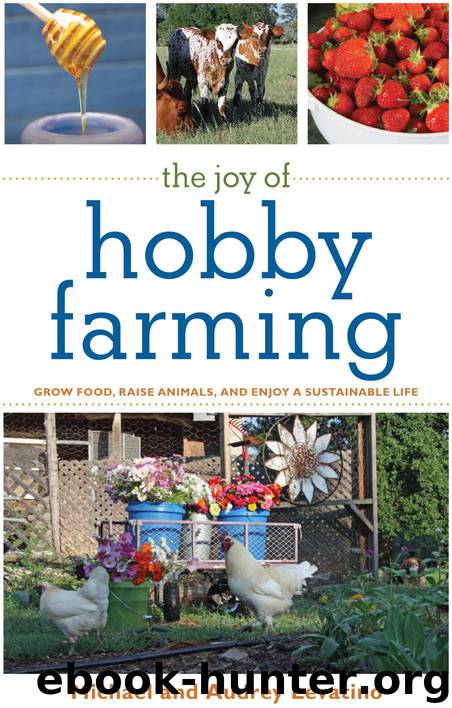The Joy of Hobby Farming

Author:Michael Levatino
Language: eng
Format: mobi
Publisher: Skyhorse Publishing, Inc.
Published: 2011-02-18T18:30:00+00:00
BELOW: A row of lisianthus grows at Green & Gold Farm.
Woody ornamentals, perennial trees and shrubs, are another extension of the cutting garden. Although most “woodies” are traditionally landscape plants, they can serve double duty by providing interesting cuts to bring indoors. Examples of commonly found woody ornamentals are buddleia (butterfly bush), forsythia, hydrangea, and lilac.
Bulbs, Corms, and Tubers
Bulb, corm, and tuber flowers are an upfront expense and can be quite costly. Bulbs also require extra digging, which means extra time and effort, to plant them at the required depth. The advantage of planting bulbs is that you then have flowers early in the season. In April, people are eager for a bright burst of color after the bleak coldness of winter. We got a late start that first year. We didn't really begin to plan out our flowers until December, by which time it was far too late to plant bulbs. We didn't have enough flowers to attend a market until the very end of June! Bulbs do take up quite a bit of space, but in many cases (i.e., tulips) growers till them up after harvesting them, thus treating them as an annual crop. This makes sense if you need the space for other crops that season, but it cuts your profit margin drastically. In general, most bulbs whose flowers are cut will not return with the strength and vigor of bloom they produced in their first year.
Most tuberous, or rhizome, flowers are more expensive and are meant to return year after year. Examples of these are dahlias and tuberose. They do not have to be planted as deeply as most bulbs, and many have the advantage of producing more than one bloom per tuber. An important consideration when selecting bulbs, corms, and tubers for your garden is whether or not they are hardy enough for your climate and can be left in the ground over winter. Depending on your hardiness zone, some bulbs and tubers may need to be dug up and stored in peat moss or sawdust over the winter months. If you must store bulbs and tubers over the winter make sure you have a dry, dark space that is protected from rodents. Some bulbs, corms, and tubors will naturalize—return each year and even multiply. Check the hardiness zone for each variety. If you do leave your bulbs, corms, and tubers in the ground over the winter, be aware that they make tasty meals for voles and other critters.
Annuals
The greatest volume of flowers in a cutting garden are produced from annuals, those flowers that live only one season and must be replanted each year. Prime examples of these are larkspur, sunflowers, and zinnias. How much space you devote to each variety of flower depends mostly on the size of the plant at full growth, and how many of them you need and want for your markets. As always, much will be learned through experience. Our first year of growing cut flowers we woefully underestimated our customers’ desire for giant yellow sunflowers.
Download
This site does not store any files on its server. We only index and link to content provided by other sites. Please contact the content providers to delete copyright contents if any and email us, we'll remove relevant links or contents immediately.
| Container Gardening | Hydroponics |
| Organic | Propagation & Cultivation |
| Topiary | Urban |
| Water Gardens & Ponds |
Turbulence by E. J. Noyes(7975)
The Thirst by Nesbo Jo(6873)
Gerald's Game by Stephen King(4606)
Be in a Treehouse by Pete Nelson(3995)
Marijuana Grower's Handbook by Ed Rosenthal(3640)
The Sprouting Book by Ann Wigmore(3559)
The Red Files by Lee Winter(3388)
The Remains of the Day by Kazuo Ishiguro(3339)
Sharp Objects: A Novel by Gillian Flynn(2981)
Christian (The Protectors Book 1) by L. Ann Marie(2669)
Organic Mushroom Farming and Mycoremediation by Tradd Cotter(2658)
The Culinary Herbal by Susan Belsinger(2450)
Stone Building by Kevin Gardner(2369)
The Starter Garden Handbook by Alice Mary Alvrez(2305)
Lilac Girls by Martha Hall Kelly(2271)
The Unlikely Pilgrimage of Harold Fry by Rachel Joyce(2241)
The Lean Farm Guide to Growing Vegetables: More In-Depth Lean Techniques for Efficient Organic Production by Ben Hartman(2106)
Urban Farming by Thomas Fox(2081)
Backyard Woodland by Josh VanBrakle(1909)
